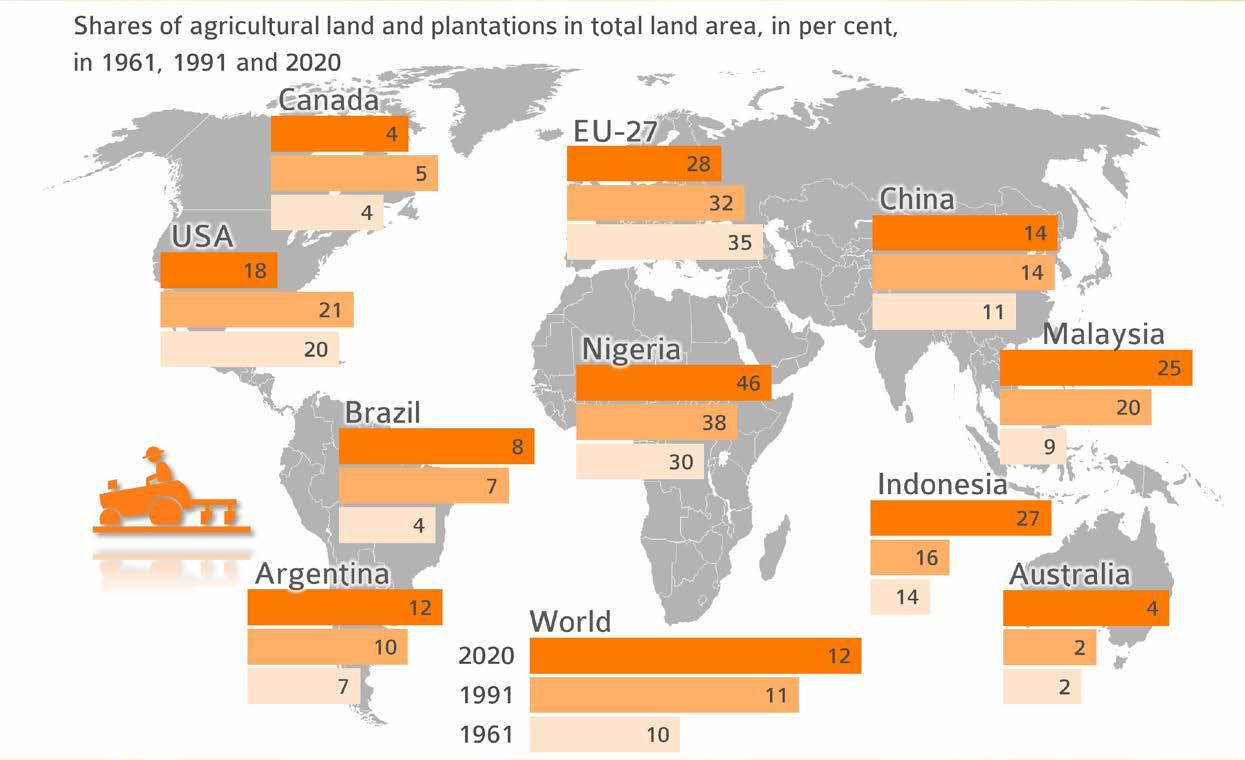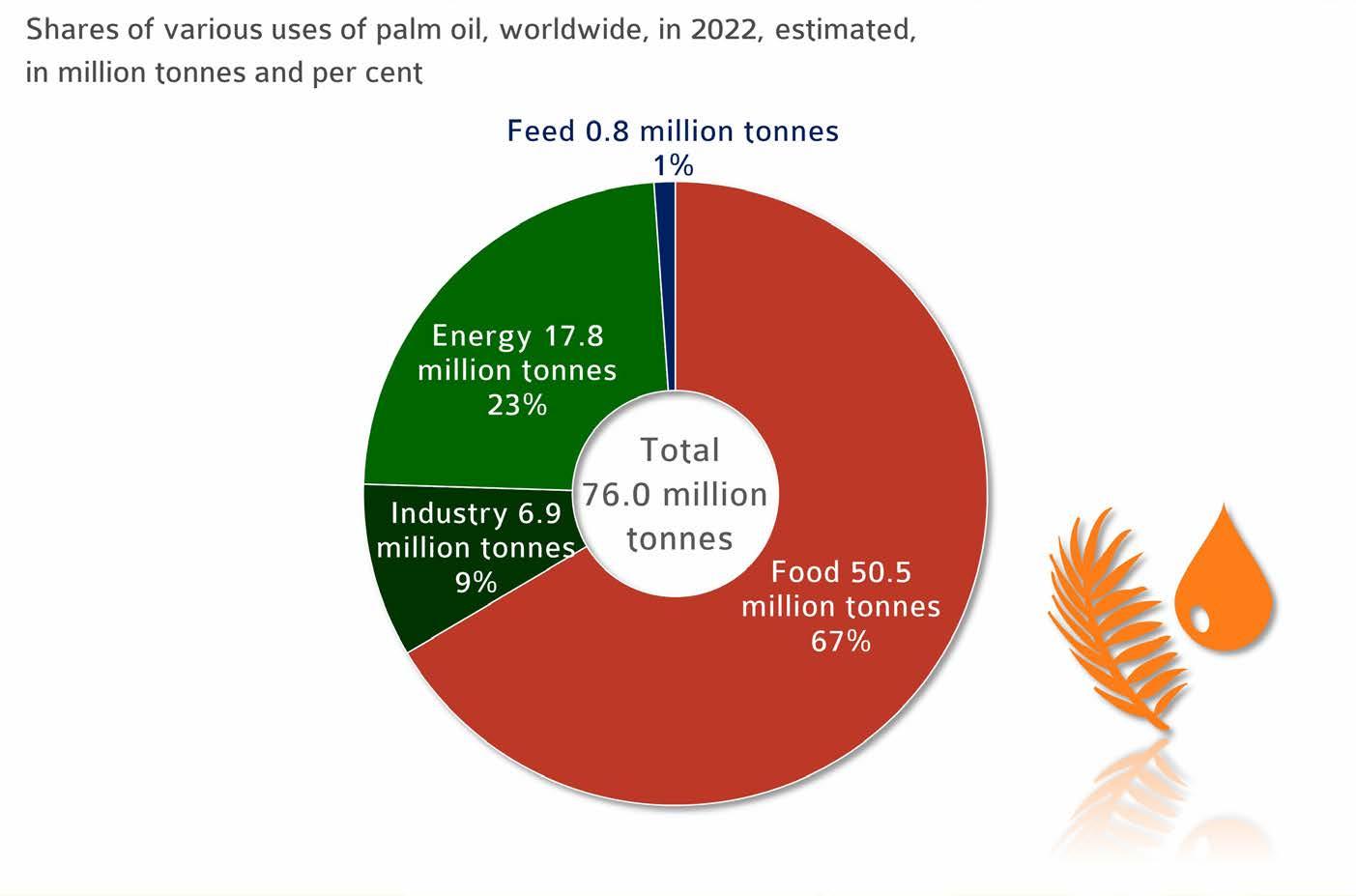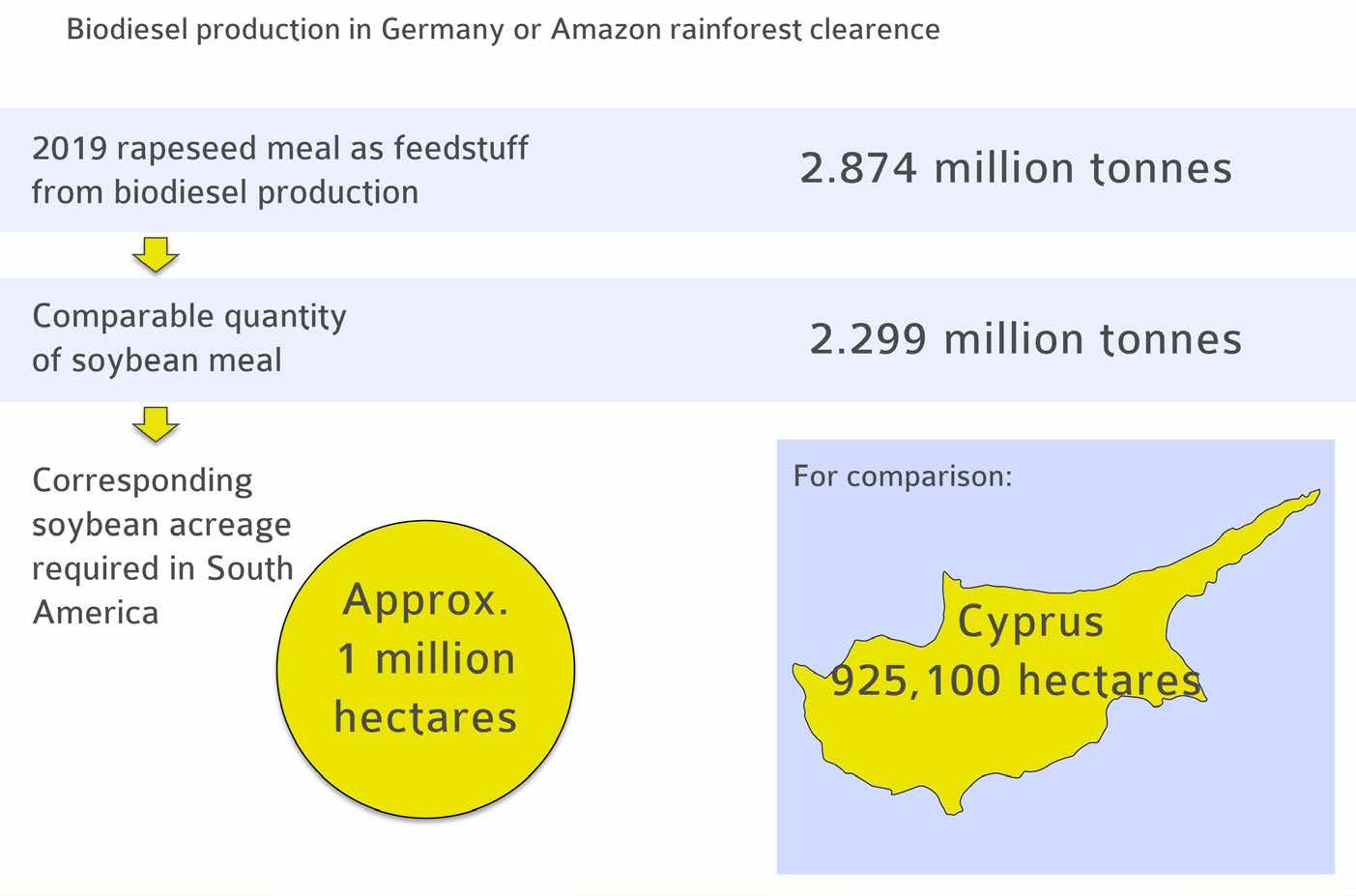
4 minute read
Land use
4.1 Does growing energy crops create a lack of land for food crops?
» 4.1.1 Shares of land used for biofuels production
Advertisement
Crop plants were grown on more than 1.4 billion hectares worldwide in 2021. These include grain, oilseeds, protein, sugar and fibre plants, fruits, vegetables, nuts and others. Most of these crops were used directly or indirectly, via livestock feeds, for human nutrition. Only around 8 per cent of the area was used in biofuels production. Biofuel production is mostly located in countries where there is already a surplus of feedstock (especially maize and soybeans). If the surplus were not used to produce biofuels, it would have to be placed on the global market, where it would weigh heavily on already low feedstock prices. The conversion of agricultural feedstock to biofuels reduces the production overhang, generates extra value added and reduces the need for foreign currency for imports of crude oil or fossil fuels. The latter is primarily a problem in poorer countries. Another advantage of biofuel production is that it also yields high-quality protein feedstuffs, which are in high demand. The share and quality of these protein feeds have a strong influence on feedstock prices and consequently on the size of the area planted. This holds true especially for soybeans. Biofuels are by no means the price drivers in the commodities markets. If necessary, the feedstocks grown for biofuel production are primarily available for food supply. If arable farming were to be extensified for political reasons – an aim the EU Commission is pursuing with the reduction strategy for fertilisers and plant protection products under the “Green Deal” – this option of “buffering” food demand would no longer be available.
Biofuels take up little space
Sources: OECD, USDA, Oil World
4.1 Does growing energy crops create a lack of land for food crops?
» 4.1.2 Development of cropland
The primary purpose of agriculture has always been to feed a growing world population, taking into account the changes in eating habits due to higher incomes. This purpose requires a sustainable intensification and growth of agricultural production. Between 1961 and 2020, cropland increased by 212 million hectares to 1,562 million hectares. Around 10 per cent of the globe’s land was used for arable farming some 60 years ago; that figure had risen to 12 per cent as of 2020. In the southern hemisphere, these increases are first and foremost based on expansions of area planted, along with progress in production methods (seed, fertilisers, crop protection, agricultural engineering). In the northern hemisphere, on the other hand, cropland is decreasing. Sustainable increases in productivity primarily result from research and innovation at universities and companies from the chemical and plant breeding industries. This progress is achieved as a result of farmers’ high levels of qualification, good professional support and prompt implementation of new insights in agricultural practice. However, the trend in the EU to promote extensification through political regulations gives rise to concern. Global

The conversion of primeval forest and other land required to protect the environment and climate is the subject of growing controversy. Binding sustainability requirements should be created for all production regions to certify the production of biomass – irrespective of its final use –and trace back the origins of the feedstocks. The EU’s biofuels policy, more specifically the revision of the Renewable Energy Directive (RED II), tightens documentation and greenhouse gas reduction requirements, which for the first time also apply to solid biomass. The aim is to create a level playing field for global fair competition without any environmental or social dumping.
4.2 Is there a limit to the use of palm oil?
» 4.2.1 Global use of palm oil
Oil palm is the single most important oleaginous fruit crop in Southeast Asia, but is also grown to a considerable extent in Colombia and Nigeria. Like other vegetable oils, it is ideal for a wide range of uses in food (67 per cent), oleochemical items (just less than 7 per cent) or as a feedstock for biofuel (just less than 18 per cent). Global palm oil consumption in 2022 is estimated at 76 million tonnes. The majority is used as edible oil in Southeast Asia. Global palm oil production is increasing due to the expansion in area by clearing primeval forest legally and illegally and replanting with high-yielding hybrid varieties. However, the growth in global demand is lagging behind. This has the result that more and more palm oil surplus is processed into biodiesel in the main palm oil producing countries and governments are raising blending quota requirements step by step. In Indonesia, the quota for non-public transport is already at 30 per cent. The EU is reducing the use of palm oil for biofuel production. The Renewable Energy Directive (Red II) stipulates that the use of palm oil-based biofuels will no longer be eligible for credits to meet quota obligations or climate goals by 2030 at the latest. In France, Austria, Belgium and other EU member states, crediting is no longer permitted even now. In Germany, crediting will not be possible from 2023 onwards. Nevertheless, world consumption of palm oil will probably pick up, especially for food uses.
Palm oil is primarily food

4.3 What would protein feed supply be like if there was no biodiesel?
» 4.3.1 Land required for soybeans if German biodiesel production did not exist
Rapeseed meal takes on special importance in relation to the demand for a boost in self-sufficiency in feed protein. What makes this kind of feed protein so special compared to imported oilseed meals is that it is GM-free. It is also lower priced than adequate alternatives, such as GM-free soybean meal, and it generally has short distances for transport and processing. In Germany, there are 13 locations (oil mills) that process rapeseed into meal. Extracted rapeseed meal and rapeseed expeller are by-products of rapeseed processing and obtained together with rapeseed oil. The latter is used both as a feedstock for food and for biodiesel production. If demand for rapeseed oil were to decline because the use of cultivated biomass for biofuels would be politically restricted, supply of rapeseed meal from domestic production would dwindle as well. However, rapeseed meal is urgently needed, because annual demand of oilseed meal in Germany amounts to 7.5 to 8 million tonnes. Without sales of rapeseed oil-based biodiesel, supply of rapeseed meal would decrease approximately 3.4 million tonnes and have to be offset by alternatives. In terms of soybean meal equivalents, these alternatives would amount to 2.7 million tonnes. This volume, which translates to a soybean area of just less than 1 million hectares, could not come from Germany or the EU-27. For comparison, this is a larger area than the island of Cyprus. It is more likely than not that soybean producers in America, especially in South America, would close this gap by expanding cropland further. This would only be at the cost of the primeval forest.

Biodiesel or deforestation
© AMI 2022 | Source: AMI









